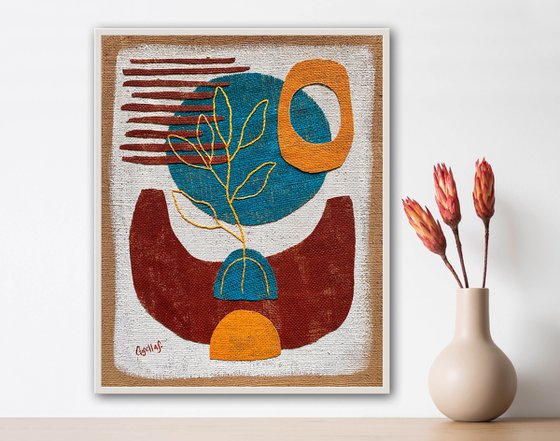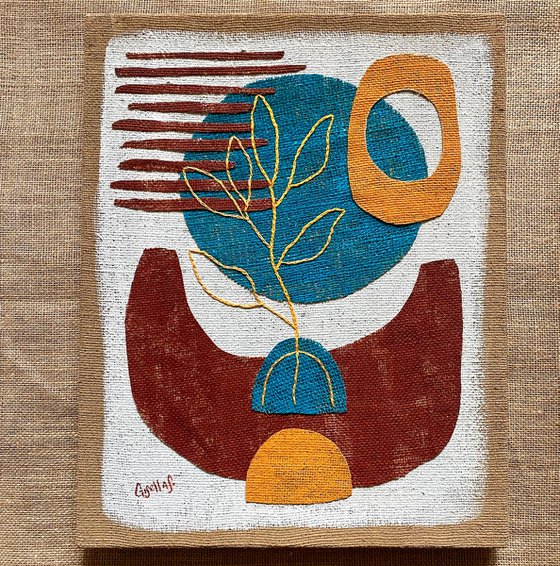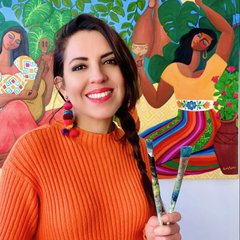- By medium
- By subject
- By budget
- Sales
- Gift cards
- Discover all art
- Artists
- Editors’ picks
- Ideas
Original artwork description:
Nature is inspiring all this serie of organic abstracts that I'm working on at the moment.
This work has been created with recycled jute (Latin American coffee bags) and embroidery. Lately I am exploring materials that allow me to create a more sustainable and environmentally conscious art, in my process the recycled jute coffee bags are painted, cut and reconstructed in organic abstracts and arcing contour body silhouettes. I also use embroidery in my works as a tool for female empowerment and peaceful protest, I consider the embroidery as a space of freedom, introspection, self-knowledge and sisterhood.
About jute:
Known as the 'golden fiber' or Burlap, jute is the vegetable fiber extracted from the stem and bark of the plant called white jute (Corchorus capsularis) Jute is 100% natural, ecological, biodegradable, reusable and recyclable.
The extraction of the fiber is carried out mainly using biological processes, without the use of chemicals. The stems are submerged in water to separate the fibers.
Its cultivation is rainfed. It does not need irrigation, it feeds on rainwater.
It is one of the strongest and most resistant natural vegetable fibers.
Its growth is very fast, usually 4–6 months.
It can be cultivated in arid lands. The cultivation of jute enriches the fertility of the soil, allowing it to be used for other crops, such as rice. For all these reasons, we could say that jute is one of the most environmentally friendly fibers that exists
Materials used:
Acrylic paint, Jute coffee bag, embroidery threads
Tags:
#abstract #nature #roots #embroidery #organic abstract #jute #recycled materials #sustainable artwork #coffee sacksRaiz (Root) (2022) Acrylic painting
by Gisella Stapleton
6 Artist Reviews
£890 Sold
- Acrylic painting on Fabric
- One of a kind artwork
- Size: 40 x 50 x 4cm (unframed)
- Ready to hang
- Signed on the front
- Style: Organic
- Subject: Flowers and plants
Do you like this artwork?
This artwork has sold, but the artist is accepting commission requests. Commissioning an artwork is easy and you get a perfectly personalised piece.
Loading
Original artwork description
Nature is inspiring all this serie of organic abstracts that I'm working on at the moment.
This work has been created with recycled jute (Latin American coffee bags) and embroidery. Lately I am exploring materials that allow me to create a more sustainable and environmentally conscious art, in my process the recycled jute coffee bags are painted, cut and reconstructed in organic abstracts and arcing contour body silhouettes. I also use embroidery in my works as a tool for female empowerment and peaceful protest, I consider the embroidery as a space of freedom, introspection, self-knowledge and sisterhood.
About jute:
Known as the 'golden fiber' or Burlap, jute is the vegetable fiber extracted from the stem and bark of the plant called white jute (Corchorus capsularis) Jute is 100% natural, ecological, biodegradable, reusable and recyclable.
The extraction of the fiber is carried out mainly using biological processes, without the use of chemicals. The stems are submerged in water to separate the fibers.
Its cultivation is rainfed. It does not need irrigation, it feeds on rainwater.
It is one of the strongest and most resistant natural vegetable fibers.
Its growth is very fast, usually 4–6 months.
It can be cultivated in arid lands. The cultivation of jute enriches the fertility of the soil, allowing it to be used for other crops, such as rice. For all these reasons, we could say that jute is one of the most environmentally friendly fibers that exists
Materials used:
Acrylic paint, Jute coffee bag, embroidery threads
Tags:
#abstract #nature #roots #embroidery #organic abstract #jute #recycled materials #sustainable artwork #coffee sacks14 day money back guaranteeLearn more





